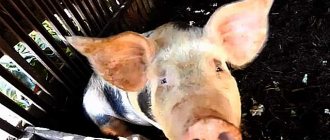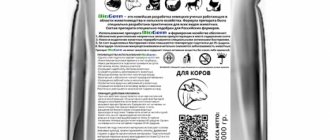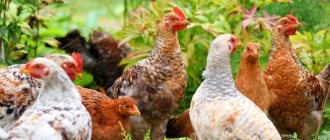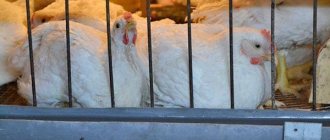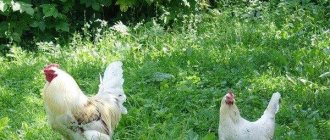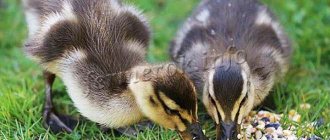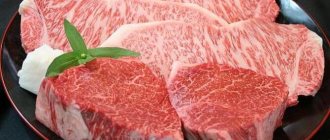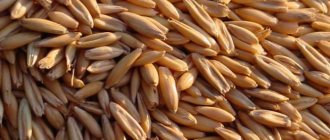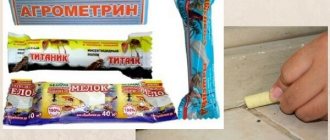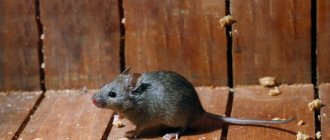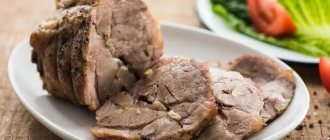In livestock farming, feed conversion ratio
(
FCR
) or
Feed Conversion Ratio
is the ratio or rate measuring the efficiency with which livestock bodies convert animal feed into the desired output.
Dairy cows, for example, produce milk, while animals raised for meat (such as beef, cows[1], pigs, chickens and fish) produce flesh, that is, the body weight received by the animal, represented either in the final weight of the animal, or a mass dressed exit. FCR is the mass of feed divided by the yield (thus mass of feed divided by mass of milk or meat). In some sectors, feed efficiency
, which is output divided by input (i.e. the inverse FCR), is used. These concepts are also closely related to ingestion efficiency (ECI).
The concept of feed conversion
Conversion is the ratio of the amount of feed consumed to a unit of product received.
The lower this indicator, the less efficient the enterprise is. Low conversion indicates that the feed is of high quality and the feeding process is organized correctly. Conversely, an increase in this parameter indicates irrational livestock rearing. In Russian complexes, the approximate feed conversion rate in pig farming is 2.8. If the coefficient is 3.9-5, the enterprise is unprofitable.
Feeding control – there is a lot of room for improvement here
Feeding control is needed to answer the question: why do our animals do what they do? And thanks to this question we can find reasons.
If we want to determine feed conversion, we first need to measure the feed intake rate of our herd. This means that the amount of food consumed must be regularly recorded (or better yet, recorded) and the dry matter content in it must be regularly determined (in a complete mixed diet or in individual components).
In addition, one is interested in what the actual productivity from the main feed is. Does the resulting milk yield correspond to the calculated one obtained during the calculation and preparation of the diet, and does the calculated consumption of concentrates correlate with the amount of milk received?
What does feed conversion depend on?
Feed conversion in pig farming depends on 2 parameters:
- How well animals can absorb incoming nutrients.
- How actively food is digested.
The first factor is largely determined by the proper work of the livestock specialist, who must draw up a balanced nutrition program for animals, taking into account their age and needs. It is important to choose the best feed that will fully meet the needs of pigs. The second factor is due to the peculiarities of the digestion process, i.e. directly depends on the health of the gastrointestinal tract of animals.
With proper organization of animal husbandry, pig feed conversion can be reduced significantly. Veterinarians identify a number of important factors that farmers are advised to pay attention to.
High temperatures reduce the appetite of piglets, and as a result, weight gain slows down. At low temperatures, animals eat more food to stay warm. But due to the acceleration of metabolism, the mass does not increase. Therefore, when building a closed pen, it is important to pay attention to the ventilation system. It will help maintain the optimal temperature in the room.
The area of the room has a direct impact on conversion. If animals have enough free space, feed consumption becomes most efficient. Pigs do not overeat, but they gain weight.
Body weight gain slows down if pigs of different breeds are in the same pen. On the one hand, this is due to the occurrence of stress, and on the other hand, due to frequent fights due to divergence of “interests”.
Mature individuals absorb nutrients worse. As a result, weight gain grows more slowly. Therefore, it is important to organize the slaughter of old livestock in a timely manner and replace it with young ones.
Diet management is a key conversion factor. The pig should receive as much energy as it needs (neither more nor less) so that there is no unnecessary cost of feed.
- Air temperature.
- Population density.
- Mixing different breeds.
- Age of animals.
- Nutrition.
Fattening pigs must include:
- cereals – barley, oats, corn, peas;
- root vegetables - potatoes, beets, carrots;
- herbaceous plants - nettle, rapeseed;
- fish, meat, dairy products, meat and bone meal;
- premixes and growth stimulants.
Specialized food "AgroVitEx" is the best feed for optimal conversion! They are balanced in composition, fully satisfy the needs of animals of different ages, and are created on the basis of the latest scientific achievements.
content
Feed conversion ratio (FCR) is the ratio of inputs to outputs; it is the inverse of "feed efficiency" which is the ratio of outputs to inputs. FCR is widely used in swine and poultry, while IP is used most often with cattle. Being a ratio, FCR is dimensionless, that is, it is independent of the units used to define FCR.
FCR is a function of the genetics and age of the animal, the quality and ingredients of the feed, as well as the conditions in which the animal is kept, and the storage and use of feed by farm workers.
Typically, daily FCR is low for young animals (when relative growth is high) and increases for older animals (when relative growth tends to level off). However, FCR is a poor basis to use for selecting animals for genetic improvement because it results in larger animals that cost more to feed; instead of residual suction flow (RFI), which is used independent of size. RFI is used to derive the difference between actual intake and predicted intake based on the animal's body weight, weight gain, and composition.
Yields may be calculated on the basis of the weights obtained, on all animals at sale, or on the dressed product; with milk can be normalized for fat and protein content.
As for the input portion, although FCRs are usually calculated using a dry mass feed, they are sometimes calculated as a saturated wet mass basis, (or, in the case of grains and oilseeds, sometimes on a wet mass basis at standard humidity), with the moisture feed resulting in more high ratio.
Animals have reduced conversion
Author: Daria Kharitonova/Agro-Business magazine
Despite the growth in pork and poultry production, peasants still had no confidence that Russia could become a country with intensive livestock farming. In the last three years, with relatively stable harvests, the sown area has hardly grown, while grain exports have increased. Consumption of grain for feed, according to Rosstat, now amounts to 38 million tons/year. Many analysts estimated the demand for fodder in similar figures, promising a medium-term increase in its consumption (up to 1 million tons/year). Given such assessments, the peasants did not exclude that in a few years grain producers would not be able to feed the growing number of livestock.
Where do the extra millions come from?
Now the Russian Grain Union (RGU) and the Institute for Agricultural Market Studies (IKAR) are trying to dispel these doubts, having published their own estimates of the increase in livestock and demand for feed. According to RZS President Arkady Zlochevsky, if the current growth rate of livestock farming continues, by 2012 Russian farms will most likely need only 3.5 million tons of fodder more than now. And if we assume that by that time our meat producers will completely replace imports with their products, then the demand for grain will increase by 7.5 million tons, he adds. Previously, taking into account the higher feed conversion, the RZS spoke about 11 million tons.
According to Zlochevsky, livestock farmers will be able to save grain by reducing the grain component in feed (now it reaches 80%) and increasing the protein content, and most importantly, reducing conversion. To increase the weight of cattle by 1 kg, Zlochevsky predicts, in 2012 farms will spend 3, and poultry - 1.7 kg of feed (currently 3.5 and 2). And ICAR calculated that in modern pig farms the ideal conversion can be 2.5 kg, while old ones spend up to 6 kg of feed to get a kilogram of pork.
However, even now Rosstat attributes an “extra” 3 million tons of grain to livestock farmers, the RZS decided. Zlochevsky proves that in fact, 35 million tons of fodder are consumed in this sector per year, and Rosstat calculates domestic consumption figures based on old conversion data. In Soviet times, it was 3.6 kg in poultry farming and up to 8 kg in pig farming, recalls Zlochevsky. Therefore, when calculating the grain balance, the statistical agency obtains inflated figures for the demand for fodder, he explains. Zlochevsky emphasizes that when calculating the demand for feed, the union’s analysts relied on current conversion rates. If the forecast for its decline comes true, then in six years farmers will need even less feed grain.
Who is smaller?
Pig farmers will be the furthest ahead in reducing feed consumption, experts say. But they are still far from ideal conversion. According to the head of the executive committee of the National Meat Association, Sergei Yushin, “very few” of the best enterprises now maintain a conversion of 3.2-3.4. He includes Omsk Bacon, Usolsky Pig Farm, Miratorg and SV-Povolzhskoe among them. “And in the future, if we want to remain competitive, we must strive for the performance of leading European manufacturers, whose conversion is no higher than 2.8-3 kg,” says Yushin.
At Miratorg, according to the company’s general director Alexander Nikitin, the conversion rate is “slightly above three.” He hopes to achieve the indicators named by Yushin in three to five years. One of the technological solutions for this will be the construction of a feed mill that will launch in December. “Conversion rates will improve due to improved quality of feed,” explains Nikitin. “We will develop improved feeding formulas, increasing the content of proteins, mineral supplements, vitamins and premixes in the diets.”
Concentrate consumption
If in this case the use of concentrates begins with 14-15 kg of milk, and it is taken as a guide that about 2 kg of milk should be produced from 1 kg of feed, then for a dairy cow with a daily milk yield of 30 kg, the daily amount of concentrates should be about 8.5 kg (taking into account the displacement of the main feed by concentrates).
If the enterprise in question with 45 dairy cows has a herd milk yield of 30 kg of milk, then the daily consumption of concentrates would be 383 kg.
Such a control calculation could be done in another way. The target indicator for the consumption of concentrates per kg of milk for a highly productive herd (and giving concentrates separately) is 280 g. In this enterprise there are 45 dairy cows, if the average productivity is 30 kg / head per day, a total of 1350 kg of milk is produced per day . From this amount we obtain a concentrate consumption of 378 kg/day (1350*0.28=378 kg of feed).
One supply of feed, for example, 6 tons, should be enough for approximately 15 days (at the enterprise, in addition to dairy cows, other groups of animals, for example, calves and young animals generally consume a small amount of feed)
Rumen villi provide a high level of feed conversion
The stomach of ruminants is actually divided into four compartments. The scar is the first compartment, the largest in size, the second compartment is a mesh, much smaller in size. The third compartment, called the book, is slightly larger than the mesh. The fourth compartment, called the abomasum, is similar in function to the simple stomach of other animals. Of the total capacity of the four compartments, rumen accounts for 80%, mesh 5%, book 7%, abomasum 8%. Mesh, tripe and book have no glands and therefore do not produce acids or digestive juices. However, since they lack proteolytic enzymes and hydrochloric acid, they provide an excellent growth medium for many types of microorganisms eaten in feed. Thanks to the action of these microorganisms, coarse materials containing complex polysaccharides, cellulose and lignocellulose are broken down.
The increase in the relative size of the proventriculus of calves with age occurs mainly due to the rumen, since the relative size of the mesh and book decreases. The growth characteristics of the proventriculus and abomasum in calves are directly dependent on the nature of their feeding and, in particular, on the amount and duration of feeding them milk, as well as on the timing of their accustoming to eating rough plant feed. Early habituation of calves to eating roughage and large amounts of it given to young animals contributes to a more intensive growth of the volume of the rumen, netting and book; At the same time, the growth of abomasum slows down.
The main site of absorption of the final products of digestion are microscopic finger-like projections - villi. They are lined with columnar epithelial cells through which nutrients pass. Inside the villi are small capillary blood and lymphatic vessels that collect the absorbed material. The study of the physiology of villous epithelial cells is an extremely important topic. Absorption through these cells turned out to be a very specific process. Digestion is not simply a process of producing water-soluble materials. It is known that sucrose and lactose are water-soluble, but they are not absorbed until they are broken down into simple sugars - hexoses.
With the concentrated type of feeding, the population size of cellulolytic microflora in the rumen decreases, which negatively affects the digestibility of fiber in bulk feeds in the diet. This leads to a decrease in their palatability and a reduction in the duration of chewing gum. As a result, conditions are created that disrupt the natural mechanisms of protecting the rumen from acidosis.
The growth rate of calves during the milking period depends on many factors: month of birth, live weight at birth, milk production of mothers, quantity and quality of additional feeding.
While the young animals are fed milk, the calf is not a ruminant animal, since liquid feed passes by the rumen and is digested by the acids and enzymes of the rennet, and the rumen remains undeveloped. In order to stimulate the rapid development of all parts of the digestive system, already on the 3-4th day, calves are accustomed to starter feed or oat grain. To do this, a small amount (pinch) of oats is placed on the root of the tongue with your hands. After ingestion, it enters the rumen, which is the starting condition for the development of the rumen.
Early introduction of calves to concentrated energy feeds has several benefits: villi development, rumen enlargement, and increased skeletal and muscle development. Compound feed entering the rumen, due to the products of their biological fermentation, contributes to the thickening of its mucous membrane while simultaneously stimulating the development of papillae. At the same time, the surface of the rumen walls and the absorption area increase. The resulting fatty acids strengthen the micron base of the intestinal walls. The diet of young animals should contain 10-12% structural fiber.
Experiments to study effective ways to stimulate the development and functioning of the rumen of young cattle were carried out on the basis of the Gorodets dairy farm of Priyutovarogaz LLC. According to the principle of analogous pairs, two groups of newborn calves of the black-and-white breed, 10 heads each, were formed. The conditions of housing and feeding in both groups during the period of the experiments were the same. In the first control group, calves first received colostrum and were switched to whole milk and milk replacer. Gradually, the calves were accustomed to roughage (hay) and crushed grain fodder.
In addition to milk, the calves of the second experimental group received whole oats mixed with barley and starter feed.
The control slaughter of calves was carried out: one head at the start of the experiment (photo 1), one head after 30 days (photo 2) and at the end of the experiment after 63 days (photos 3-4). At the end of the experiments, the best animals were selected from each group. Photo 1 shows that the walls of the scar are smooth, white and very tender.
In photo 2 we also see smooth walls of the scar, but at the same time folds appear and due to this the suction surface increases, the volume of the scar is increased, and the walls are thickened.
Photo 3 shows that villi have appeared on the rumen wall of calves that received milk, hay and crushed grain mixture. The length of the villi is 2-3 mm, the walls of the scar are thickened and rougher.
In photo 4 we see a fully formed rumen wall in calves that received whole oats mixed with barley and starter feed as part of their diet, the villi are densely located, the length of the villi is 4-5 mm, the rumen walls are thick.
In the first six months of life, when the calves' feed intake is limited, a high concentration of energy in the dry matter of the diet is required, so at this stage the animals should receive special feed and main feed only of the best quality. Otherwise, they will not be provided with energy, since the main feed does not contain enough energy and is often of poor quality, and young calves can only digest 50-60% of the nutrients contained in the main feed. High-quality concentrates are required as a source of energy.
Domestic livestock breeders have the opinion that the more and longer a calf is given milk or milk replacer, the better its development and higher weight gain. As our research and the experience of leading farms show, this approach to raising calves is not only economically unprofitable, but also hinders the intensive growth and development of the body.
After the cessation of drinking, the average daily weight gain decreases, the calves lose weight and are stunted in growth, because long-term feeding of young animals with milk or its substitute sharply reduces the relative weight of the rumen and prevents the development of the normal structure of its mucous membrane. But it is the rumen that is the real “factory” that processes the main feed. In this regard, when raising young dairy cattle, it is recommended to accustom calves to eating concentrated and roughage feeds as early as possible.
Conversion factors for livestock
Animals that have a low FCR are considered efficient feed users. However, comparison of FCR among different species may not be meaningful unless the feeders involved are of similar quality and suitability.
Cattle
In 2013 in the US, a live weight gain FCR of 4.5-7.5 was in the normal range with an FCR above 6 being typical. As of 2013, FFR has not changed much compared to other areas in the previous 30 years, especially compared to poultry, which has improved feed efficiency by approximately 250% since the late 1800s.
Dairy cattle
The dairy industry has not traditionally used FCR, but in response to increasing concentrations in the dairy industry and other livestock operations, the EPA updated its regulations in 2003 to control manure and other waste emissions generated by livestock operators. In response, the USDA began issuing recommendations to dairy farmers on how to control inputs to better minimize manure output and minimize harmful contents, as well as optimizing milk production.
In the US, milk is priced in terms of protein and fat content, so FCR is often calculated to take this into account. Using FCR calculated only on the weight of protein and fat, as the 2011 FCR 13 was poor, and FCR 8 very good.
Another way to combat protein and fat based pricing is to use energy adjusted milk (ECM), which adds a factor to normalize by assuming certain amounts of fat and protein in the final dairy product; that the formula is (0.327 x milk mass) + (12.95 x fat mass) + (7.2 x protein mass).
In the dairy industry, feed efficiency (ECM/intake) is often used instead of FCR (intake/ECM); An FE of less than 1.3 is considered problematic.
FE based simply on milk weight is also used; FE between 1.30 and 1.70 is normal.
Pigs
As of 2011, pigs used commercially in the UK and Europe had an FCR, calculated to increase in weight from approximately 1 as piglets and ending at approximately 3 at slaughter. As of 2012 in Australia and used in carcass weight at exit, FCR calculated dressed weight of 4.5 was fair, 4.0 was considered "good", and 3.8 was "very good". In the US as of 2012, commercial pigs had an FCR calculated using weight, 3.46 for while they weighed between 240 and 250 pounds, 3.65 between 250 and 260 pounds, 3.87 between 260 and 270 pounds , and 4.09 between 280 and 270 lbs.
Because FCR is calculated based on weight, it gets even worse after the pig matures as it takes up more and more feed to stimulate growth, countries that have a culture of slaughtering pigs at very high weights, like Japan and Korea, have poor FCR .
Some data for sheep illustrate changes in FCR. FCR (kg feed dry matter intake per kg live weight gain) for lambs is often in the range of around 4 to 5 on high concentrate diets, 5 to 6 on some good quality feeds, and more than 6 on lesser quality feeds. On a straw diet, which has a low concentration of metabolizable energy, the FCR of lambs can be as high as 40. All else being equal, the FCR tends to be higher for older lambs (eg 8 months) than for younger lambs (eg 4 months).
Domestic bird
As of 2011 in the US, broilers have an FCR of 1.6 based on body weight gain, and mature in 39 days. Around the same time, the FCR based on weight gain for broilers in Brazil was 1.8.
For laying hens used in egg production in the United States, as of 2011 the FCR was about 2, with each hen laying about 330 eggs per year.
From the early 1960s to 2011, the growth rate of broilers in the United States doubled and their TFR doubled, largely due to improved genetics and the rapid spread of improved chickens. Improved genetics for raising meat have created problems for farmers who raise chickens raised in the broiler industry, as genetics that cause rapid growth have decreased reproductive abilities.
Sorting of piglets during growing and fattening and its impact on production performance
Working with our clients in Russia and visiting nursery and fattening sites, we often hear the question: “How to properly sort piglets when transferring to nursery and fattening?”
In other words, our clients ask us about how to properly position piglets during weaning, growing and finishing in such a way as to achieve maximum weight gain. First, we need to understand that not all piglets come to nursery the same. They differ in weight, health and age, albeit not by much, but there is a difference. This means that it would be correct to assume that they require different conditions of detention and approaches to working with them. That is, the conclusion suggests itself that if we sort piglets by their weight into small, medium and large, we will create the best conditions for each weight category of piglets. It sounds logical, but there are experimental results that show that if piglets are not sorted by weight at all, production indicators at the end of the growing period will be better (Table 1).
Table 1. Effect of pig sorting at placement on growth rate and feed conversion during growing.
Sorting by weight
Weaning weight, kg
Transfer weight, kg
ab (P Source: Cargill NA study 1760 pigs 45 days in nursery.
As can be seen from the experimental results, without sorting pigs by weight, greater weight gain can be achieved with the same feed conversion. That is, we can conclude that there is no need to sort pigs during production.
What then to do with the smallest piglets? After all, they may differ from others not only in weight, but also in age, and then they need additional conditions.
So let's take a look at PIC's approach to weaner placement plans. We recommend that when weaning and placing piglets for rearing, you separate the smallest piglets and place them in separate pens (at the rate of 10% of the total number of incoming pigs). And the remaining piglets (medium and large) should not be sorted and placed in other pens. Further in the growing process, pigs do not need to be sorted at all and left in their pens. By not sorting pigs by size, pen space can be used effectively. When a pig lies in a pen, it occupies a space that is equal to the area of the animal's belly and side. And if you put medium and large pigs together, you can significantly reduce competition for space.
Then another question arises: what to do with the lagging piglets? Our approach to this issue is such that when weaning and placing piglets for rearing, it is also necessary to leave several pens empty (at the rate of 10% of the total number of incoming pigs), which are filled within the first three days after placement. The first three days are enough to identify pigs that are not able to compete with their brothers in the pens, and in three days they will not yet have time to establish a hierarchy in the pens.
Next, we want to consider the need to sort pigs when entering fattening (Table 2).
Table 2. Effect of pig grading at placement on growth rate and feed conversion during finishing.
Sorting by weight
Final weight, kg
Source: Feed conversion in pig production, J.Patience 2012.
If you do not sort pigs when placing them for fattening, you can achieve greater weight gain, reduce feed conversion and increase the overall sales weight of the group.
But in addition to all the advantages of applying the above-described approach to the placement of animals for growing and fattening, there is another very important positive point. Namely, the implementation of the right implementation strategy. What is an implementation strategy? This is when we go into the fattening hall about three weeks before the main sale and select the so-called “champions” (the heaviest pigs) from each pen. Why do we need to do this? In modern conditions of intensive industrial pig production, the productivity of sows has greatly increased (the influence of rapid genetic progress, which is achieved using the various tools we described in technical articles earlier), which has produced more piglets weaned. At the same time, the conditions of rearing and fattening have not changed, which means that there is more competition among pigs for feed, water, planting area and ventilation. And this competition greatly slows down the growth rate of animals in the final stages of fattening. This is where the sales strategy comes to our aid, when after selecting a certain number of pigs before the main sale, we free up more space, feeding and watering fronts, as well as ventilation for the remaining pigs in each fattening pen.
To achieve maximum and inexpensive weight gain from weaning to sale, you need to correctly place the piglets at weaning, and not sort them during the entire growing period. Then transfer the pigs from pen to pen for fattening (the growing pen is placed in the fattening pen without sorting) and then also do not sort them until they are sold. This approach to the placement of animals will help you implement the right sales strategy and ultimately sell more kilograms of meat in live weight per square meter of growing and fattening. And more meat sold means more profit for your business.
Post an ad
| 105 735 | agricultural advertisements |
| +1 467 | during the week |
join us
© 2022 agro-industrial bulletin board “Agribusiness Market” User Agreement
Article rating:
Feed conversion in livestock farming: what is it and how to reduce it Link to main publication
Related publications
- Granulated beet pulp - use in livestock diet
Where are the reserves hidden?
When ensiling basic feed, dry matter and nutrients are lost. These losses cannot be avoided, and they amount to about 10%.
But losses in practice very often amount to 20-30%, which greatly changes the situation. This means that up to 30% less feed will be fed net than was collected gross. This consequently increases the cost of feed.
But the most expensive silage is the one that has not been fed, and this is due to
- making silage
- silo trench maintenance
- distribution of feed and
- management of feeders/feed table
Other studies, for example from the Chamber of Agriculture of North Rhine-Westphalia, look at the question of how much of all the energy produced by silage will later actually be processed, that is, converted into milk or used to support the life of the animal and its pregnancy.
Here the difference is even greater. A large proportion of self-produced energy from feed is not processed properly and turns out to be completely ineffective and expensive.
The second most expensive silage is that which has been harvested but not processed, and the reasons for this are related to
- feed quality
- composition of the diet (combinable/incompatible feeds)
- animal health
- animal living environment (area, stress)
- handling animals.
Herbal meal
To prepare flour from herbs, alfalfa, meadow grass, clover, beans, pigweed and cereals are used. This non-traditional feed additive is used to saturate the main feed with crude proteins, carotene and amino acids. It should be added to the feed mixture no more than ten percent for chickens and no more than fifteen percent for adults.
Dry nettle flour is also used, which contains a lot of fiber, protein, fats and vitamins. It must be added ten grams per bird to the daily feed dose.
Use of non-traditional and extruded feed in Russia
Russian farmer Alexey Bukharovsky began farming poultry quite a long time ago. His poultry farm is located in the Urals, the owner is engaged in raising different breeds of poultry and prefers to feed his charges with non-traditional and extruded feed, since the rate of feed consumption in poultry farming and the healthy growth of poultry are for him the most important components of a successful business.
By choosing this feeding method, the farmer noticed that feed consumption was cut in half, and his birds began to produce much more food than before. For this reason, Alexey advises his colleagues to abandon standard feed mixtures and switch to extruded ones in order to ensure an increase in livestock and additional income for the farm.
Feed composition
In addition to this comparison of the consumed amount of feed with the calculated amount according to the compiled diet, an accurate understanding of the composition of the feed is of great importance. Only if all components in the feed and their % ratio are known without gaps, the farmer and consultant have the opportunity, in addition to the energy and crude protein content, to also check the content of starch and rumen-stable starch in the diet, as well as the indicators of digestible and non-digestible protein in the rumen and the balance nitrogen in the rumen - all these are very important criteria when calculating the diet and controlling feeding.
Grain and products of its processing
Grains are the main source of carbohydrates that birds can easily digest and absorb. Such feed additives are mainly represented by corn, wheat, oats and barley. In rare cases, millet is used, as it contains too much fiber and lysine, which interfere with the normal digestion of feed.
Removing the shell from millet grain increases its nutritional value and allows it to be given to chickens immediately after birth. In non-traditional feeding, birds also use gluten flour, which is given to young birds to accelerate growth. With its help, it is possible to significantly reduce feed conversion and increase live weight gain.
Leguminous crops
Some poultry farms add meat and bone meal, rapeseed, vetch, lupine, peas and soybeans to standard feed additives. In this way, it is possible to add protein and amino acids to the poultry’s diet.
For a long time, such feeds were not used in Russian poultry farming at all, since they contain substances that have a negative impact on poultry productivity. But when scientists conducted a series of tests and learned how to remove them using different species. A species is an evolutionarily established set of individuals characterized by a single ... treatment, then these feeds began to be gradually introduced into the bird’s diet. Moreover, processing allows not only to remove undesirable substances, but also to increase the digestibility of such food by fifteen percent. And in order to reduce the alkaloid percentage, they began to breed and grow legumes without this harmful element.
In order for a bird’s diet to be complete, it is enough to add fifteen percent of grain legumes to standard feed mixtures, and then the bird will receive the amino acids, fats, protein and fiber it needs.
Case Study Documentation
The company from the north of Schleswig-Holstein has been keeping daily records of feed quantities for several years now, and this has become a firmly established part of daily feeding and feed control. The herd of dairy cows here is divided into two groups, which are fed two different diets (in the form of PSR). The daily downloaded quantities are first recorded and usually entered into an Excel spreadsheet at the end of the week. The composition of the current diet is also entered here, and the daily consumption of individual components is automatically calculated. The consumption of components is summarized weekly and monthly, thanks to which you can plan inventories and orders of purchased components (Table 1).
Milk milk is also entered into the file (in this enterprise milk is collected once every two days), the consumption of milk for feeding the calves is automatically subtracted and then recalculated into kilograms. In this way, the consumption of individual concentrates and the total amount of feed per kg of milk are automatically calculated.
Ultimately, a convenient overview of the development of feed consumption and milk yield is obtained (graph 1). These graphs very quickly show what the herd reacts to particularly sensitively, in this case – to the chlamydia vaccination on 12/11/2015.
Moreover, records are kept of the cost of the main feed prepared on the farm and the prices actually paid for concentrates, thanks to which the cost of feed per kg of milk is visible on a daily basis (Graph 2).
